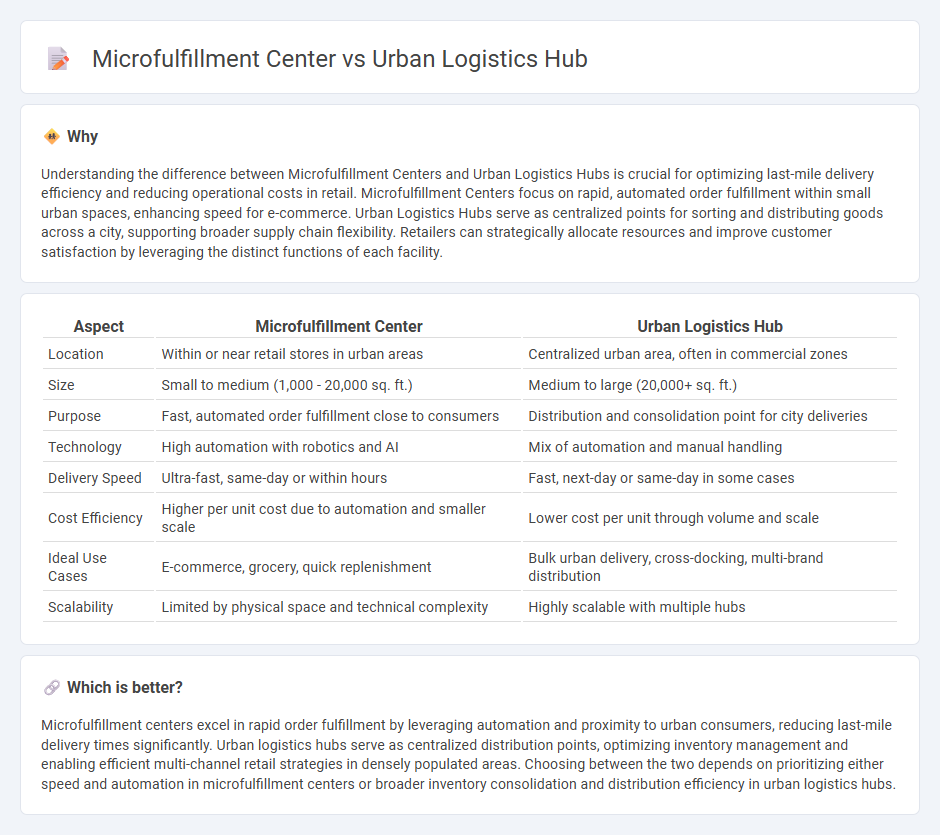
Microfulfillment centers optimize retail supply chains by enabling rapid order processing and localized inventory management, significantly reducing delivery times in dense urban areas. Urban logistics hubs serve as centralized distribution points that streamline last-mile delivery, integrating various transportation modes to enhance efficiency in metropolitan environments. Explore the advantages and applications of these innovative retail logistics solutions.
Why it is important
Understanding the difference between Microfulfillment Centers and Urban Logistics Hubs is crucial for optimizing last-mile delivery efficiency and reducing operational costs in retail. Microfulfillment Centers focus on rapid, automated order fulfillment within small urban spaces, enhancing speed for e-commerce. Urban Logistics Hubs serve as centralized points for sorting and distributing goods across a city, supporting broader supply chain flexibility. Retailers can strategically allocate resources and improve customer satisfaction by leveraging the distinct functions of each facility.
Comparison Table
| Aspect | Microfulfillment Center | Urban Logistics Hub |
|---|---|---|
| Location | Within or near retail stores in urban areas | Centralized urban area, often in commercial zones |
| Size | Small to medium (1,000 - 20,000 sq. ft.) | Medium to large (20,000+ sq. ft.) |
| Purpose | Fast, automated order fulfillment close to consumers | Distribution and consolidation point for city deliveries |
| Technology | High automation with robotics and AI | Mix of automation and manual handling |
| Delivery Speed | Ultra-fast, same-day or within hours | Fast, next-day or same-day in some cases |
| Cost Efficiency | Higher per unit cost due to automation and smaller scale | Lower cost per unit through volume and scale |
| Ideal Use Cases | E-commerce, grocery, quick replenishment | Bulk urban delivery, cross-docking, multi-brand distribution |
| Scalability | Limited by physical space and technical complexity | Highly scalable with multiple hubs |
Which is better?
Microfulfillment centers excel in rapid order fulfillment by leveraging automation and proximity to urban consumers, reducing last-mile delivery times significantly. Urban logistics hubs serve as centralized distribution points, optimizing inventory management and enabling efficient multi-channel retail strategies in densely populated areas. Choosing between the two depends on prioritizing either speed and automation in microfulfillment centers or broader inventory consolidation and distribution efficiency in urban logistics hubs.
Connection
Microfulfillment centers and urban logistics hubs are interconnected through their shared goal of enhancing last-mile delivery efficiency in retail. Microfulfillment centers enable rapid order processing close to consumers, while urban logistics hubs consolidate shipments for streamlined distribution within dense city environments. This synergy reduces delivery times, optimizes inventory management, and lowers transportation costs in urban retail networks.
Key Terms
Location Density
Urban logistics hubs strategically position large-scale distribution centers near city centers to leverage high location density for efficient bulk goods handling and last-mile delivery. Microfulfillment centers operate within smaller, hyperlocal spaces such as urban storefronts or warehouses, optimizing rapid order fulfillment in densely populated areas. Explore how these models redefine supply chain efficiency and customer satisfaction in metropolitan markets.
Order Volume
Urban logistics hubs manage high order volumes by consolidating large shipments for efficient last-mile delivery in densely populated areas. Microfulfillment centers process smaller, frequent orders with rapid turnaround, leveraging automation for speed and accuracy in urban retail contexts. Explore deeper insights into optimizing order volume strategies for both facility types.
Last-Mile Delivery
Urban logistics hubs centralize inventory and streamline distribution within city limits, reducing transit times and improving delivery efficiency for e-commerce and retail sectors. Microfulfillment centers, typically smaller facilities located closer to end consumers, leverage automation to accelerate the picking and packing process, enabling rapid last-mile delivery in densely populated urban areas. Discover how these innovative solutions transform last-mile logistics and optimize urban supply chains.
Source and External Links
Urban logistics hubs: Six case studies - Urban logistics hubs are strategically located urban facilities that consolidate, sort, and dispatch freight, optimizing last-mile delivery and reducing negative environmental impacts.
Urban Logistics Hubs Summary and Conclusions - OECD - Urban logistics hubs serve as key nodes managing freight consolidation and last-mile shipments, improving delivery efficiency while aligning with sustainability goals.
Urban Logistics Hubs - International Transport Forum (ITF) - Urban logistics hubs address the complexity and environmental challenges of city freight transport by providing space for consolidated, sustainable goods distribution within urban areas.
 dowidth.com
dowidth.com